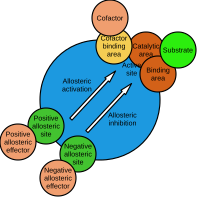Allosteric regulation

Allosteric regulation is like having a special button on a toy that changes how it works.
Imagine you have a toy car with a button on the top. When you press the button, the car's wheels move faster or slower. This button is a special feature that changes how the car works.
In the same way, a protein can have a special spot called an "allosteric site" that can change how the protein works. When molecules, called "effectors," bind to this spot, they can either turn the protein on or off, or change its activity in some other way.
For example, imagine you have a protein that helps your body break down glucose. Normally, this protein works at a certain rate to break down glucose. But let's say you eat a lot of sweets and your body needs to break down more glucose. A molecule called ATP might bind to the protein's allosteric site, turning it on and making it work faster.
Overall, allosteric regulation is like having a special button on a toy that can change how it works, and proteins in our bodies can have their own special spots that change how they function based on the molecules that bind to them.
Imagine you have a toy car with a button on the top. When you press the button, the car's wheels move faster or slower. This button is a special feature that changes how the car works.
In the same way, a protein can have a special spot called an "allosteric site" that can change how the protein works. When molecules, called "effectors," bind to this spot, they can either turn the protein on or off, or change its activity in some other way.
For example, imagine you have a protein that helps your body break down glucose. Normally, this protein works at a certain rate to break down glucose. But let's say you eat a lot of sweets and your body needs to break down more glucose. A molecule called ATP might bind to the protein's allosteric site, turning it on and making it work faster.
Overall, allosteric regulation is like having a special button on a toy that can change how it works, and proteins in our bodies can have their own special spots that change how they function based on the molecules that bind to them.
Related topics others have asked about:
